"We are what we repeatedly do. Excellence, then, is not an act, but a habit." --Aristotle
Address any questions or comments regarding this newsletter to the individual authors listed after each article or to its editor, Rick Weinzierl, 217-333-6651, weinzier@illinois.edu. To receive e-mail notification of new postings of this newsletter, call or write the same number or address.
In This Issue:
Bill Shoemaker to Retire (reception June 7, 2012, at the Kane County Extension Office)
Regional Updates (from western Illinois)
Notes from Chris Doll (crop phenology, thinning, flower bud initiation, Summer Horticulture Day)
Fruit Production and Pest Management (oriental fruit moth and codling moth updates; apple curculio)
Vegetable Production and Pest Management (potato leafhopper, European corn borer, corn earworm, armyworms and cutworms)
MarketMaker (YouTube videos with step-by-step instructions on how to use MarketMaker)
Bill Shoemaker to Retire
Bill Shoemaker, currently the Superintendent and Senior Research Specialist at the University of Illinois St. Charles Horticultural Research Center is retiring at the end of next month after 30 years with the University of Illinois. A reception in his honor is scheduled for Thursday, June 7, 2012, from 3:00 to 7:00 p.m. at the University of Illinois Kane County Extension Office, 535 S. Randall Rd., St. Charles. Bill's research and outreach programs in fruit and vegetable production have been based in northern Illinois for more than twenty years. He currently is the Regional Viticulture Specialist for the Illinois Grape Growers & Vintners Association and conducts work in grape breeding, evaluating cultivars for winter hardiness, and investigating IPM and training systems for optimizing wine production.
Bill has been very supportive of the Master Gardener program with his pumpkin production as well as space and resources for the Kane County Inmate Garden. Please join us to acknowledge and thank Bill for his years of service and to wish him well in his retirement. We'll have light refreshments and stories to tell as we look back on his career with Extension. If you are unable to attend but would like to have an email or card given to Bill, please address your card to Ruth Thompson, 535 S. Randall Rd, St. Charles, IL 60174. Gift checks can be made out to Ruth Thompson and sent to the same address. Please rsvp for the reception to rathomps@illinois.edu or call 630-584-6166.
Upcoming Programs
- Quincy-area Market Farm Tour, May 29, 2012, 8:00 a.m. – 2:00 p.m. Meet at 8:00 a.m. at Mill Creek Farm, 2833 S. 48th, Quincy at 8:00 a.m. Mike and Theresa Roegge operate the farm, which has outdoor and high tunnel production. Their produce is sold through a stand on the farm as well as some wholesale. Second stop will be at Terripin Farms, 3011 N. 90th, Fowler. Brad and Jessica Whiston and Josh Huffman grow all their produce outdoors, with the majority on plastic. They market through two CSA's as well as several Farmers' Markets. The last tour stop will be at Lubbert Farm, 1427 N. 2250th Avenue, Mendon. Chuck and daughter Beth grow organic produce, almost exclusively in four high tunnels. They market their produce via email and central pickup once per week. Registration is $10 per person to cover lunch. Register on line at http://web.extension.illinois.edu/abhps under “Market Garden Tour" on the right.
- Food Safety: From Garden Gates to Dinner Plates, June 4, 2012, 6:00-9:00 pm., at the University of Illinois Extension Office in Kankakee. For more information and to register, see http://web.extension.illinois.edu/units/event.cfm?UnitID=472&EventID=57860 or call the Kankakee County Extension Office at 815-933-8337.
- Pest Identification and Management, June 5, 2012, at the Phelps Schoolhouse, 2959 N. 2100 E. Rd. in Fairbury (Livingston County). For more information and to register, see http://web.extension.illinois.edu/units/event.cfm?UnitID=477&EventID=57788 or contact Chris Konieczka, University of Illinois Extension, at cmkonie@illinois.edu or call 815-842-1776.
- Openfields Farm Tour, Jo Daviess, Stephenson and Winnebago Counties, June 10, 2012, noon – 4:00 p.m. University of Illinois Extension invites you (and your family) to take part in the 4th Annual Openfields Farm Tour. Pick and choose your destinations on this no cost, self-guided tour of local farms, fields, and gardens in northern Illinois. Meet local producers and learn about locally grown food. For more information, see http://web.extension.illinois.edu/units/event.cfm?EventID=58182&UnitID=462.
- High Tunnel Workshop, June 11, 2012. Workforce Careers Center, Lincoln Land Community College, 9:00 a.m. to 4:30 p.m. Mike Bollinger and local growers will cover developing a planting plan, planting, and management topics including insect and weed control and winter growing. Registration is $30. (A discounted rate of $50 will be charged to participants who sign up for this and the May 12 workshop listed above.) Registration includes a box lunch and copies of two books, The Polytunnel Handbook and The Winter Harvest Handbook. For more information and to register, see www.llcc.edu/greencenter or contact Julie Bates at julie.bates@llcc.edu or 217.786.2434. Hosted in conjunction with University of Illinois Extension and funded with the assistance of the Illinois Community College Board and the Illinois Department of Commerce and Economic Opportunity.
- Illinois Summer Horticulture Day, June 14, 2012, at Kuipers Family Farm near Maple Park, Illinois. Kuipers' Family Farm features a pick-your-own orchard and pumpkin shop, a bakery, a Barn Store, and many entertainment activities. For more information, see www.kuipersfamilyfarm.com or www.specialtygrowers.org. For reservations, use www.ilsthortsoc@yahoo.com or call 309-828-8929.
- Openfields Farm Tour, Logan, Menard, and Sangamon Counties, June 24, 2012, noon – 4:00 p.m. University of Illinois Extension invites you (and your family) to take part in the 1st Annual Openfields Farm Tour. Pick and choose your destinations on this no cost, self-guided tour of local farms, fields and gardens in central Illinois. Meet local producers and learn about locally grown food. For more information, see http://web.extension.illinois.edu/units/event.cfm?UnitID=483&EventID=58224
- Is Entrepreneurial Farming for You?, July 26, 2012, 5:30 – 9:00 p.m. at the University of Illinois Extension Office in Springfield. A workshop to provide assistance to aspiring farmers with new business ideas. For more information and to register, see https://webs.extension.uiuc.edu/registration/?RegistrationID=6818 or contact Deborah Cavanaugh-Grant at cvnghgrn@illinois.edu or call 217-782-4617.
Regional Updates
In western Illinois ... Warm weather has pushed development of early planted crops. First-planted sweet corn (mid to late March) emerged within 7 days and is now showing tassels in the whorl. Stands look excellent, much better than most of the corn planted in April. Soil temperatures declined during April, and a 3-week lag between planting and emergence was not uncommon. Several insect pests have been noted in sweet corn, including European Corn Borer (ECB) and armyworm. In one field ECB infestation was 37%.
Matted row strawberry harvest is in full swing. Yields are somewhat varied, depending upon irrigation practices last summer and frost events of April 10-12 this year. This area received only 2" of rainfall from July 1 through mid-October. Strawberries initiate flower buds during late summer/early fall, and unfavorable/stressful conditions during that time period can affect yield.
Harvest of early season vegetables is ongoing. Greens, radishes, spring onions, cole crops, asparagus, peas, potatoes, and more are being harvested. Asparagus harvest has been ongoing since late March to early April. Some are electing to discontinue picking mature stands as the 7-8 week harvest window has arrived. The past few years of excessively wet soils have reduced the vigor of mature asparagus stands due to root decline (in saturated soils with no oxygen, root growth has been diminished). Allowing sufficient opportunities for the crop to manufacture and store carbohydrates for next years' spring spear growth is essential.
The efficacy of many herbicides will be tested this year. The area received rains April 30-May4, but nothing since. Generally speaking, 0.5-1 inch of rainfall is necessary within 10-14 of herbicide application to activate soil-applied herbicides. The dry soils have also adversely affected the germination of recently seeded vegetable crops. Irrigation (where available) has been used for some crops already.
Cabbage loopers have been noted for the past 3 weeks in head lettuce and cole crops. Cucumber beetles also are troublesome for some producers. A number of companies are offering cucurbit seed treated with FarMore seed treatment. This treatment contains a systemic insecticide plus three fungicides. Many growers have found the treatment to be excellent for controlling early season cucumber beetles (up to first true leaf).
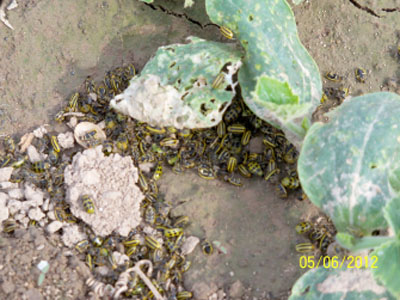
Cucumber beetle mortality on zucchini seedlings where seed was treated with Farmore seed treatment by the seed company.
Mike Roegge (217-223-8380; roeggem@illinois.edu)
Notes from Chris Doll
After several fantastic May days with temperatures in the 50's to 70's and fairly "normal" growth, perennial crops remain well ahead of "normal" development. With the near-term forecast of above normal temperatures into the mid-90's, there will should be no decrease in the number of days we are ahead of schedule. Memorial Day used to be near-peak harvest time for strawberries in this region, but it is now renovation time. Black and red raspberry harvest has begun (5/23/12), in comparison with June 8-10, 2011. Early varieties of blueberries are blue and somewhat edible. On the negative side, my records show that Japanese beetles emerged on the same dates as the begriming of the raspberry harvest last year.
Chemical thinning of apples is history in this part of Illinois, and we all have sympathy for the growers of frosted and frozen crops in other regions. That includes growers of all fruits. For some local apple growers, the concern is about the failure of some thinning attempts, and the potential for crop failure on varieties such as Fuji next year due to overcropping. Dr. Steve McArtney of North Carolina State told us about his research on flower bud initiation and how adding 5 ppm of NAA in four dilute sprays (can be included in cover sprays) beginning in mid-June increased return bloom in all experiments. (Note: some adjustment in timing should be made for the northeast North Caroling latitude and this year's early season). He noted too that continuing the NAA up to harvest was also beneficial, but cautioned that using the chemical into pre-harvest, like in pre-harvest stop-drop sprays, may hasten maturity of the fruit. An alternative to NAA for the return bloom is a single application of a dilute spray of ethephon between five and seven weeks after bloom, at rates ranging from 24-96 ounces per acre.
I've been reading about de-fruiting severely frozen apple trees with ethephon so as to reduce insect sprays for pests like codling moth. It should work yet in some of the late blooming areas. There appears to be concern that next year's flower bud initiation on those trees will cause more problems with thinning. Will the ethephon de-fruiting spray increase the bud set?
Peach thinning in this area is near the end. From here on out, it should be a matter of overcoming missed clusters and a chance to improve pack-out by eliminating smaller and damaged fruit. Harvest dates have not been set, but will be early.
The Illinois State Horticulture Society Summer meeting is at the Kuipers' Family Farm near Maple Park Illinois on June 14. I hope to see many of the readers there with me to see the many fine changes in plantings and direct marketing that have been added since purchasing from the family of Tom Milnemow.
Chris Doll
Fruit Production and Pest Management
Degree-day Updates for Oriental Fruit Moth and Codling Moth
The second flight of oriental fruit moth (OFM) is well underway or beginning throughout southern and central Illinois. Based on a 45-degree F developmental threshold, degree-day accumulations through May 9 at three locations were approximately:
Oriental Fruit Moth | ||
|---|---|---|
Location |
Biofix Date |
Degree-days (base 45F) from biofix through May 22 |
Carbondale |
March 18 |
1297 |
Belleville |
March 18 |
1394 |
Urbana |
March 24 |
1063 |
Second-generation flight starts at around 950 DD (base 45F) after the beginning of first generation flight. So ... protecting peaches from infestation by OFM larvae is especially important over the next few weeks.
Three part-time student employees, Rob Orpet, Rachel Kirchoefer, and Aron Katz, have been working to better describe OFM and CM flight and phenology, and the data they have gathered on OFM are presented in the figure below to illustrate how the first generation OFM flight played out at Urbana, and a similar pattern likely occurred throughout the southern half (or more) of the state. The blue bars represent the number of moths per trap per night in traps in an old, unmanaged block of apples at Urbana. Red squares show the temperature at 5:00 p.m. at this site ... a somewhat arbitrary choice of time, but in the spring OFM start flying in late afternoon and early evening, and we don't expect a high proportion of moths to fly at temperatures below 60 degrees F. The greens X's show wind speeds at 5:00 p.m. ... really high winds are thought to impede flight. The point of the graph above ... flight is not consistent every day for the first generation of moths ... it's influenced by the accumulation of degree-days that govern emergence from overwintered pupae, and it's influenced by the late afternoon and evening weather conditions that determine their ability to fly and mate after they have emerged.
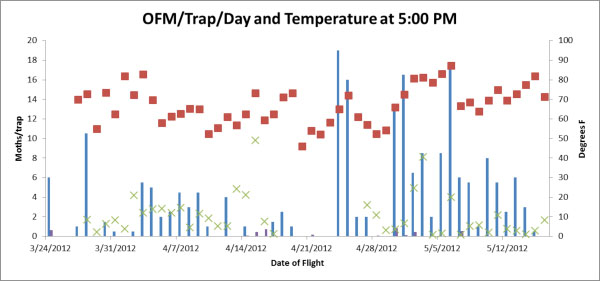
Given all those nuances, here's how the pattern of flight corresponded to base 45 F degree-day accumulations at Urbana (and very likely corresponded to degree-day accumulations throughout the region). This will be the topic of lengthy explanations during this winter's educational programs, but where degree-day accumulations were slowed by low temperatures, the cumulative emergence new moths slowed as well (as would be expected). In addition, flight and mating of moths that emerged during these periods were delayed by cool temperatures in the late afternoon and evening. In cooperation with entomologists at Michigan State University and Kansas State University, we'll be trying to determine how much these cool periods influence this pest's success in mating and laying eggs ... and the damage that results.
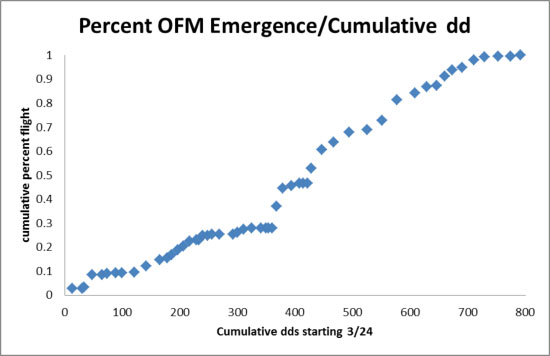
Codling moth: Degree-day accumulations based on a 50-degree F developmental threshold are summarized below, along with estimates of the status of this insect at locations ranging from southern to northern Illinois.
Codling Moth | ||||
|---|---|---|---|---|
Location |
Biofix Date |
Degree-days (base 50 F) from biofix through May 21 |
Flight status |
Egg hatch |
Carbondale |
March 30 |
821 |
1st generation complete, 2nd generation about to start |
96% of 1st generation eggs have hatched |
Belleville |
March 25 |
965 |
2-4 % of 2nd generation moth flight complete |
99% of 1st generation eggs have hatched |
Urbana |
April 25 |
423 |
80 % of 1st generation moth flight complete |
35% of 1st generation eggs have hatched |
Woodstock |
May 10 |
187 |
35-40% of 1st generation moth flight complete |
1st generation egg hatch will begin very soon |
Rick Weinzierl (217-244-2126; weinzier@illinois.edu)
Apple curculio. Most apple growers are familiar with plum curculio; a related species is the apple curculio, Tachypterellus quadrigibbus, also damages apples at about the same time. Apple curculio is smaller than plum curculio and has a longer snout. Like plum curculio, it chews an opening through the skin of small apples (around dime-size and larger) and lays an egg into the opening. It may chew several holes close together on a single fruit. The scar it leaves is round, however, not crescent-shaped, and as the fruit grows, the damaged areas may appear as raised bumps. The same insecticides and application timing used for plum curculio control also reduce damage by apple curculio.
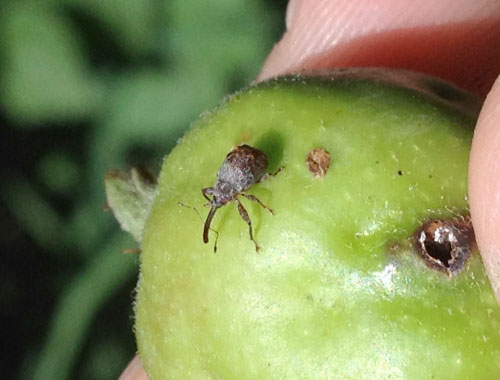
Apple curculio (photo by Aron Katz).
Vegetable Production and Pest Management
Potato Leafhopper
I've seen potato leafhopper on green beans and on redbuds in Urbana and expect that this insect has reached most area of the state. Their feeding causes cupping and browning of foliage and reduced plant growth and yield. Potatoes and snap beans are among the vegetable crops most often damaged by potato leafhopper. Check the 2012 Midwest Vegetable Production Guide for insecticides and rates for potato leafhopper control.

Potato leafhopper nymph (left) and adult (right).
Rick Weinzierl (217-244-2126; weinzier@illinois.edu)
Leps (Larvae of Butterflies and Moths) in Lots of Crops
When above-average spring temperatures push crops to develop earlier than normal, they push insects to develop faster than normal as well. Coupled with a warm winter that allowed greater overwintering survival of some species, that means we're seeing a number of pests earlier and in greater numbers than usual. Among cast of antagonists are European corn borer, corn earworm, cabbage looper, and a few species of cutworms and armyworms.
Rick Foster of Purdue University reported in their newsletter for vegetable growers that their pheromone traps for corn earworm moths were capturing moths already this spring in several locations, suggesting that this insect overwintered successfully in locations where it usually does not. Mike Roegge's note at the beginning of this issue included observations of European corn borer in whorl-stage sweet corn in western Illinois. Matt Montgomery's note below includes observations of a few other Leps as well. So ... sweet corn and tomato growers should be sure to have pheromone traps up for corn earworm as soon as corn approaches silking and tomatoes start to set fruit. And everyone should be scouting all vegetable crops for leaf feeding and plant cutting by Lep larvae (caterpillars). Use the 2012 Midwest Vegetable Production Guide to choose effective insecticides labeled for individual crops.
Rick Weinzierl (217-244-2126; weinzier@illinois.edu)
Armyworm, Yellowstriped Armyworm, and Variegated Cutworm
From Matt Montgomery ... I've received several reports of leaf feeding on vegetable crops in Fulton, Mason, Peoria, and Tazewell counties. Damage has been caused by true armyworm, yellowstriped armyworm, and variegated cutworm.
Above-average populations of true armyworms are present in wheat and popcorn. True armyworms tend to be nocturnal feeders. During the day, they curl up on the ground, typically beneath residue if they can find it. Larvae come in a range of colors (gray-green to tan). When residue is pulled back, larvae at first remain fairly still (typically curled up but occasionally sprawled out). However, in a short period of time the half inch to 1-3/4 inch long larvae begin to crawl rapidly looking for someplace else to hide such as additional residue or a soil crack. The true armyworm has a dark head capsule with a wide “V-shaped" marking between the eyes plus an orange stripe running down either side of the body. While some of these features may be shared by “look-a-like" larvae, true armyworm larvae can always be distinguished from other larvae by a series of dark bands/ diagonal black smudge-like markings on the prolegs (false legs) of older larvae. True armyworm larvae typically overwinter in the southern United States, and moths migrate back into Illinois each spring. Once here and once they have mated, females deposit eggs on the lower portion of host plant material. That host plant material can include corn, wheat, beans, cabbage, carrots, onions, peas, peppers, radishes, sweat potatoes, etc. Larvae feed for over a month and remove notches or large sections of leaf tissue on either side of the main veins. Left unchecked, all leaf tissue may be removed and plants may become soiled by frass (a polite term for insect feces). A few generations of true armyworm occur each season.
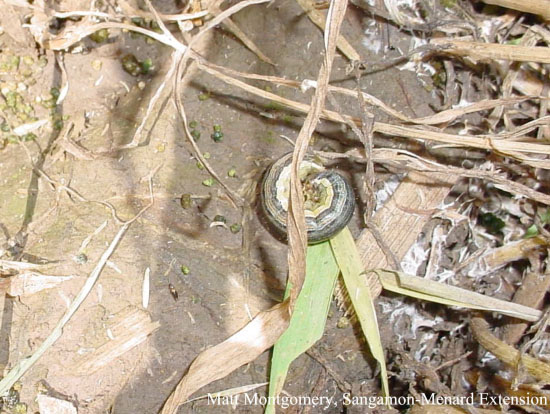
True armyworm larva.
I've also observed damage from yellowstriped armyworm in Peoria County, where about 3 percent of tomato plants in one field had been stripped of foliage. Yellow striped armyworms, while capable of devouring leaf tissue, are typically deemed more of threat to fruit in tomato production. Other crops that may be injured include greens, peppers, beans, cucurbits, etc. While occasionally observed in corn, wheat, etc., yellowstriped armyworm is typically considered a minor pest of row crops. The adult moth of the yellowstriped armyworm emerges from soil-dwelling pupae that overwinter in states just to our south. Mild winters, such as those recently encountered in Illinois, can allow this pest to survive the winter in Illinois, and this appears to be the case this year. Larvae vary in color but are typically identified by the presence of a bright yellow line running down both sides. Larvae emerge from eggs deposited in small clumps on the base of plant material or upright objects. Transplants should be monitored for evidence of feeding injury.
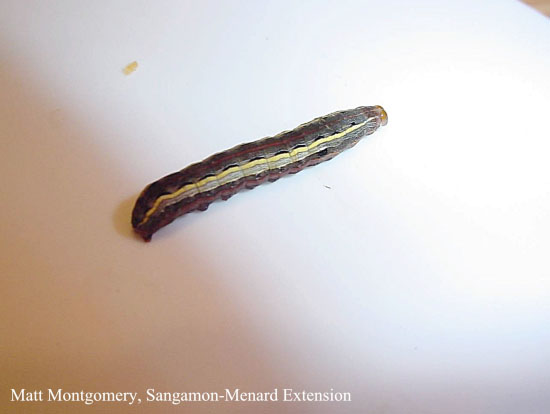
Yellowstriped armyworm.
Variegated cutworms represented the other tomato field observation in Peoria County. Variegated cutworms are slightly different from other cutworm larvae observed in the field. While other cutworms species tend to stay close the ground, variegated cutworms will climb up and crawl around on host plant material, stripping the plant of foliage, speckling the plant with frass, and leaving only the main veins behind. They can be confused with true armyworms, displaying a color spectrum that is roughly similar to that of true armyworms (green-black, to light green, to tan). Both species tend to also have orange colored head capsules. However, variegated cutworms are nearly two-inches long when full grown and have a line of yellow, diamond-shaped markings running down the back. Variegated cutworms, like armyworms, tend to hide during the day unless the day is overcast. In hay, they have even been known to hide beneath the windrow during the day feeding on alfalfa regrowth at night. Corn, wheat, alfalfa, soybean, tomatoes, potatoes, cabbage, and celery are all examples of plants devoured by this insect. As with armyworms, high variegated cutworm populations can decimate a field in just a matter of days.
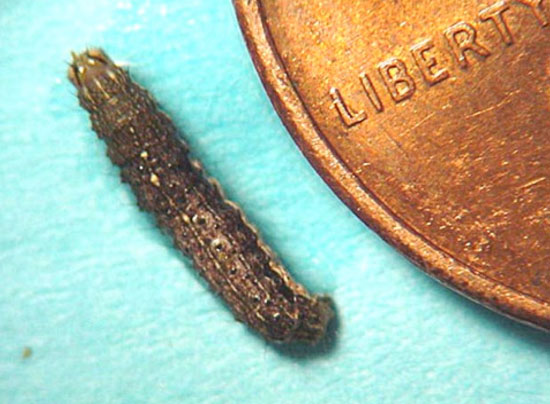
Variegated cutworm.
Scouting is always an important component of vegetable production, but scouting is especially important when addressing issues related to these three leaf feeders. Leaf feeders such as the true armyworm, yellowstriped armyworm, and variegated cutworm are best managed when small. All three species can be devastated by parasites and entomopathogens (disease), which can occasionally cause populations to collapse. Their impact upon these leaf-feeding pests should be noted during scouting to determine if management is needed. One final thought related to such leaf feeders, as noted in the field of tomatoes referenced earlier, such larvae need not feed in isolation from one another. A complex of leaf-feeding larvae may be observed in the field.
And just a reminder ... for additional images that might help in identifying these insects, use an image search image search on Google or a similar browser; there are lots of images online that provide close-ups useful for identification.
Matt Montgomery (309-547-3711; mpmontgo@illinois.edu)
MarketMaker
Tour MarketMaker with New Videos from AgMRC
Iowa State University's Agricultural Marketing Resource Center (AgMRC) has developed a series of YouTube videos that give step by-step instructions on how to use the MarketMaker database and its various functions. Craig Tordsen, Project Manager at Iowa State University, developed and produced the videos and has this to say about MarketMaker. “Our goal is to make the MarketMaker site a resource for all farmers and businesses in the food supply chain. We are as interested in helping a grocery store find farm-fresh eggs as we are in helping the farmer find a place to sell them." The videos benefit the entire MarketMaker family of states. While each state has a unique site, data from all states may be accessed from any MarketMaker location. These videos explain all aspects of the MarketMaker website. Check them out at: www.youtube.com/playlist?list=PLEF1CF11AFD5F1E1E&feature=viewall. Visit AgMRC at www.agmrc.org/.
Lori Dalfonso (309-792-2577; dalfonso@illinois.edu)
Less Seriously ...
... A Great Writer
There was once a young man who, in his youth, professed his desire to become a great writer.
When asked to define "great" he said, "I want to write stuff that the whole world will read, stuff that people will react to on a truly emotional level, stuff that will make them scream, cry, howl in pain and anger!"
He now works for Microsoft, writing error messages.
University of Illinois Extension Specialists in Fruit and Vegetable Production & Pest Management
Extension Educators – Local Food Systems and Small Farms |
||
Bronwyn Aly, Gallatin, Hamilton, Hardin, Pope, Saline, and White counties |
618-382-2662 |
|
Katie Bell, Franklin, Jackson, Perry, Randolph, & Williamson counties |
618-687-1727 |
|
Sarah Farley, Lake & McHenry counties |
847-223-8627 |
|
Nick Frillman, Woodford, Livingston, & McLean counties |
309-663-8306 |
|
Laurie George, Bond, Clinton, Jefferson, Marion, & Washington counties |
618-548-1446 |
|
Zachary Grant, Cook County | 708-679-6889 | |
Doug Gucker, DeWitt, Macon, and Piatt counties |
217-877-6042 |
|
Erin Harper, Champaign, Ford, Iroquois, and Vermillion counties |
217-333-7672 |
|
Grace Margherio, Jackie Joyner-Kersee Center, St. Clair County |
217-244-3547 |
|
Grant McCarty, Jo Daviess, Stephenson, and Winnebago counties |
815-235-4125 |
|
Katie Parker, Adams, Brown, Hancock, Pike and Schuyler counties |
217-223-8380 |
|
Kathryn Pereira, Cook County |
773-233-2900 |
|
James Theuri, Grundy, Kankakee, and Will counties |
815-933-8337 |
|
Extension Educators – Horticulture |
||
Chris Enroth, Henderson, Knox, McDonough, and Warren counties |
309-837-3939 |
|
Richard Hentschel, DuPage, Kane, and Kendall counties |
630-584-6166 |
|
Andrew Holsinger, Christian, Jersey, Macoupin, & Montgomery counties |
217-532-3941 |
|
Extension Educators - Commercial Agriculture |
||
Elizabeth Wahle, Fruit & Vegetable Production |
618-344-4230 |
|
Nathan Johanning, Madison, Monroe & St. Clair counties |
618-939-3434 |
|
Campus-based Extension Specialists |
||
Kacie Athey, Entomology |
217-244-9916 |
|
Mohammad Babadoost, Plant Pathology |
217-333-1523 |
|